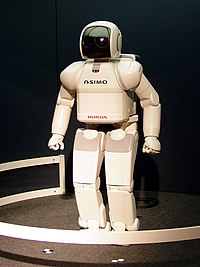
Photo from wikipedia
OBJECTIVE In this study, the authors aimed to 1) retrospectively analyze the early functional outcomes in a cohort of very young children with craniofacial dysostoses who underwent robot-assisted frontofacial advancement… Click to show full abstract
OBJECTIVE In this study, the authors aimed to 1) retrospectively analyze the early functional outcomes in a cohort of very young children with craniofacial dysostoses who underwent robot-assisted frontofacial advancement (RAFFA) or robot-assisted midface distraction (RAMD), and 2) analyze the utility of robotic assistance in improving the accuracy and safety of performing transfacial pin insertion for RAFFA or RAMD. METHODS A retrospective analysis of a cohort of 18 children (age range 1-42 months at presentation), who underwent RAFFA or RAMD from February 2015 to February 2021 in the craniofacial unit at Amrita Institute of Medical Sciences and Research Centre in Kochi, India, was performed. Inclusion criteria were patients who had undergone RAFFA in a single stage or RAMD where the cranial vault had been addressed earlier, had been addressed on follow-up, or had not been addressed and had follow-up of at least 6 months. RESULTS Overall, 18 children with syndromic craniosynostosis underwent LeFort level III midface distraction, with or without RAFFA, from February 2015 to February 2021 at a single center in India. The patients' ages ranged from 6 to 47 months at the time of the procedure. All patients had significant obstructive sleep apnea (OSA), significant ocular issues, and disturbed sleep as determined by the authors' preoperative protocol. Clinically significant intracranial pressure issues were present in 17 patients. None of the patients had injury due to the transfacial pin trajectory such as globe injury, damage to the tooth buds, or the loss of purchase during the active distraction phase. The mean distraction achieved was 23 mm (range 18-30 mm) (n = 16/18). Of the 18 patients, 10 (56%) had an excellent outcome and 6 (33%) had a satisfactory outcome. In all cases, the degree of OSA had significantly reduced after surgery. Eye closure improved in all patients, and complete closure was seen in 11 patients. On follow-up, the functional gain remained in 14 of 16 patients at the final follow-up visit. The distraction results were stable during the follow-up period (mean 36 months [range 6-72 months]). CONCLUSIONS The early RAFFA and RAMD protocols investigated in this study gave a significant functional advantage in very young patients with craniofacial dysostoses. The results have demonstrated the accuracy and safety of robotic assistance in performing transfacial pin insertion for RAFFA or RAMD.
Journal Title: Neurosurgical focus
Year Published: 2022
Link to full text (if available)
Share on Social Media: Sign Up to like & get
recommendations!